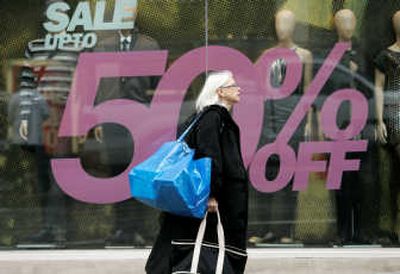Spending drop worries analysts

WASHINGTON – Consumer spending, the critical bulwark that has kept the country out of a recession, is showing signs of cracking. Retail sales plunged by 0.4 percent last month as consumers battered by a sinking housing market, rising unemployment and the credit crunch handed retailers their worst Christmas in five years.
The Commerce Department’s sales report Tuesday was just the latest in a string of weaker-than-expected numbers that have economists worried that the current economic expansion, now in its seventh year, could be in danger of faltering.
Analysts said the worry is that all the problems weighing on the economy could prompt consumers – who account for two-thirds of economic activity – to sharply limit or even stop shopping. Already, consumer confidence has slipped significantly amid the oil price spiral and the continuing housing slump. At the same time, some of the nation’s biggest financial institutions have reported billions of dollars in losses stemming from a meltdown in the mortgage market.
“There is certainly enough out there to make people worry,” said David Wyss, chief economist at Standard & Poor’s in New York. “We think we are getting very close to a recession.”
That view was echoed by former Federal Reserve Chairman Alan Greenspan, who said the country may already be in a downturn.
“The symptoms are clearly there,” he said in a Wall Street Journal interview published Tuesday. “Recessions don’t happen smoothly. They are usually signaled by a discontinuity in the market place and the data of recent weeks could very well be characterized in that manner.”
Even before the problems with December retail sales, businesses were seeing inventories rise, including a 0.4 percent increase in November. An unwanted rise in inventories can translate into future production cutbacks by factories. A key gauge of manufacturing activity gave a recession reading earlier this month, falling to its lowest level in five years.
In other news Tuesday, the Labor Department said that wholesale inflation, which had shot up in November by 3.2 percent, the largest amount in 34 years, actually dipped by 0.1 percent in December. That reflected a big drop in energy costs at the time. However, for all of 2007, wholesale prices rose by 6.3 percent. It was the biggest annual increase in 26 years.
Analysts said the dip in wholesale prices for the month of December, if followed by a benign report today on consumer prices, should give the Federal Reserve the leeway it needs to more aggressively attack the economic slowdown with interest rate cuts.
Federal Reserve Chairman Ben Bernanke last week sent a strong signal that the central bank is more worried at the moment about weak growth than inflation, prompting markets to believe the Fed will cut a key interest rate by a half-point when Fed officials meet at the end of this month.
Bernanke, who will be quizzed on the economic outlook during an appearance Thursday before the House Budget Committee, cited various statistics including a big rise in unemployment as indications that “the downside risks to growth have become more pronounced.”
Unemployment jumped from 4.7 percent in November to 5 percent in December, the biggest one-month leap since October 2001 when the country was still reeling from the shocks of the terrorist attacks.
Many economists believe that economic growth, which was powering ahead at a 4.9 percent rate in the third quarter, thanks to continued strong consumer spending, slowed to a barely discernible 1 percent rate in the final three months of last year and may now be dipping into negative territory.
To keep the gross domestic product from declining for two consecutive quarters – one rule of thumb for a recession – will require quick action by the Fed and help from Congress and President Bush, many analysts believe.